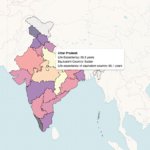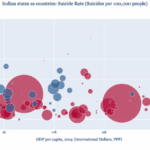Picture This: If Indian States Were Countries – Female LFPR
India’s female labour force participation fell to 16.1 percent in July-September 2020, according to a government report. According to the World Bank, India has among the lowest female labour force participation rates (LFPR) in the world.
While we are aware of India’s low female LFPR, what is the situation in Indian states? Are their female LFPR as bad as the national average suggests or are there regional variations? In this third instalment of our Picture This series on Indian states as countries, we will look at states’ female LFPR and find out which countries they find themselves closest to. In our previous two instalments, we had looked at life expectancy, and GDP per capita.
The picture above depicts states as bubbles with their GDP per capita in Intl $ (International $, which according to the World Bank, “would buy in the cited country a comparable amount of goods and services a U.S. dollar would buy in the United States.”) plotted against the x-axis, and their female labour force participation rate plotted against the y-axis. The size of the bubble is determined by the population projection for the state in the year 2019.
Indian states are depicted as blue bubbles while countries are depicted as red bubbles in the graph above. Bihar finds itself closest to the 0 in the graph. It has a low GDP (Intl $2,076) and very low female LFPR (4.3 percent). At this level of GDP, Afghanistan is the country closest to Bihar with a per capita GDP of 2,152 (Intl $) but it has a much higher female LFPR or 21.76 percent.
With a state GDP per capita of 5,345 (Intl $), West Bengal has a female LFPR of 22.2 percent. It finds itself closest to Pakistan with a GDP per capita of 4,888 (Intl $) and female LFPR of 21.67 percent. Bangladesh (right next door to West Bengal and formerly a part of Pakistan) has a GDP per capita of 4,955 (Intl $) but a much higher female LFPR or 36.37 percent.
Among states with higher GDP per capita, Haryana (GDP per capita: $11,552, female LFPR: 15.3 percent) finds itself closest to Algeria (GDP per capita: $11,997, female LFPR: 17.01 percent).
The picture above takes data for states female labour force participation rate (for women aged 15 or more) in the year 2018-19 from the Periodic Labour Force Survey (PLFS) 2018-19 released by the Ministry of Statistics and Program Implementation (MoSPI). The data for population projections in the year 2019 are taken from government projections for state populations based on Census 2011. Per capita state GDP is calculated using MoSPI report on Indian State Domestic Product 2019.
For other countries, female LFPR, population, and GDP data has been taken from the World Bank database.
While female labour force participation rates are an important marker or gender equality (or inequality) in a state, country or society, there is more to it than just numbers. In a previous post, we tried to find out if Indian women were quitting work because of increased sexual violence or is it because of how it is measured? CEDA also tried to understand the reason for slide in India’s ranking in WEF’s Gender Gap Report 2021.
If you wish to republish this article or use an extract or chart, please read CEDA’s republishing guidelines.




